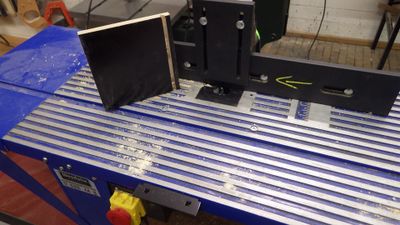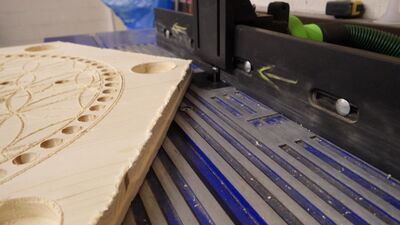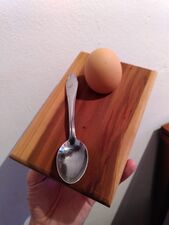Router Table: Difference between revisions
removed outdated status |
Makita 3612BR updates |
||
| Line 4: | Line 4: | ||
|synonyms=DE: Frästisch, Oberfrästisch,<br>stationäre Oberfräse | |synonyms=DE: Frästisch, Oberfrästisch,<br>stationäre Oberfräse | ||
|type=tool mount | |type=tool mount | ||
|access=[[ | |access=[[Router Table Introduction|router table introduction]] | ||
|material=[[wood]] | |material=[[wood]] | ||
|tutors=[[Tutor::User:Lukas|Lukas]], [[Tutor::User:NitramLegov|Martin]] | |tutors=[[Tutor::User:Lukas|Lukas]], [[Tutor::User:NitramLegov|Martin]] | ||
| Line 10: | Line 10: | ||
|location=[[Location::Wood Workshop|wood workshop]] | |location=[[Location::Wood Workshop|wood workshop]] | ||
|similar=[[Table Saw|table saw]] | |similar=[[Table Saw|table saw]] | ||
|used with=[[#Compatible Routers|compatible routers]], [[Push Blocks|push blocks]] | |used with=[[#Compatible Routers|compatible '''routers''']], [[Push Blocks|push blocks]] | ||
}} | }} | ||
A router table turns a [[Router|handheld router]] into a stationary tool. The router gets attached to the router table upside down in order to enable the workpiece to be fed through the router (thus, it is for a router what a [[Table Saw|table saw]] is for a [[Circular Saw|circular saw]]). | A router table turns a [[Router|handheld router]] into a stationary tool. The router gets attached to the router table upside down in order to enable the workpiece to be fed through the router (thus, it is for a router what a [[Table Saw|table saw]] is for a [[Circular Saw|circular saw]]). | ||
| Line 23: | Line 23: | ||
== (Emergency) Stop == | == (Emergency) Stop == | ||
To stop the router, you can slap the lid of the yellow switchbox or use the [[Emergency Stop|foot switch]]. When stopping inside a cut, the foot switch is highly recommended so you can keep your hands on the workpiece for full control! | To stop the router, you can slap the lid of the yellow switchbox or use the [[Emergency Stop|foot switch]]. When stopping inside a cut, the foot switch is highly recommended so you can keep your hands on the workpiece for full control! | ||
In addition to unplugging the whole setup, please make a habit of "locking" the switchbox between uses (unlocked by pushing the red cover upwards) so we have maximum protection against accidental starts. | |||
== Setup == | == Setup == | ||
=== Dust Extraction === | === Dust Extraction === | ||
[[File:Westfalia router table dust ports.JPG|left|100 px]] | [[File:Westfalia router table dust ports.JPG|left|100 px]] | ||
For edge work, you can use the top (green) dust port in the fence, but for grooves you should connect the [[Shop Vac|shop vac]] to the bottom (black | For edge work, you can use the top (green) dust port in the fence, but for grooves you should connect the [[Shop Vac|shop vac]] to the bottom port in the rear cover of the table (Ferm router: black dust port on the machine itself). Keep in mind that the top port will only work if there is at least a small gap in the fence! | ||
It will still be pretty messy work - a router generates lots of shavings - but should help reduce the amount of fine dust flying around. | It will still be pretty messy work - a router generates lots of shavings - but should help reduce the amount of fine dust flying around. | ||
| Line 53: | Line 55: | ||
'''further ideas:''' | '''further ideas:''' | ||
* make [[featherboards]] with slots that fit to the existing guide brackets | * make [[featherboards]] with slots that fit to the existing guide brackets | ||
* replace (at least) the star knobs connecting the fence and the table with [https://www.schraubenking.at/M6-Klemmhebel-Serie-45-P005030 locking levers] or knobs with hex nuts that can be gripped with [[wrenches]] (do those exist?) | * replace (at least) the star knobs connecting the fence and the table with [https://www.schraubenking.at/M6-Klemmhebel-Serie-45-P005030 locking levers] or knobs with hex nuts that can be gripped with [[wrenches]] (do those exist?) | ||
* make (or buy) a height/[[Depth Gauge|depth gauge]] to set the fence distance or bit height | * make (or buy) a height/[[Depth Gauge|depth gauge]] to set the fence distance or bit height | ||
| Line 63: | Line 62: | ||
== Compatible Routers == | == Compatible Routers == | ||
* | These [[routers]] can be attached to the table. | ||
* [[Routers#Makita 3612BR|Makita 3612BR]] (default) | |||
** do not remove without good reason! | |||
* [[Routers#Ferm FBF-1050E|Ferm FBF-1050E]] (backup) | |||
** caution: [[:File:Westfalia router table off center.JPG|the mounting plate is off-center!]] | |||
** bottom dust extraction requires the rear table cover to be removed | |||
== Inspiration == | == Inspiration == | ||
Revision as of 18:18, 31 July 2020
| MachineInfoBox Westfalia Universal Frästisch Nr. 64 56 97 | |
|---|---|
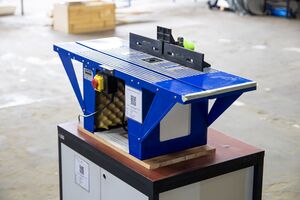
| |
| Synonyms: | DE: Frästisch, Oberfrästisch, stationäre Oberfräse |
| Material: | wood |
| Used with: | compatible routers, push blocks |
| Access Requirements: | The query description has an empty condition.Property "Needs Introduction" (as page type) with input value "The query description has an empty condition." contains invalid characters or is incomplete and therefore can cause unexpected results during a query or annotation process. |
| Manual: | Westfalia |
| Tutors: | The query description has an empty condition. |
| Similar (More or Less): | table saw |
... further resultsProperty "Has caption" (as page type) with input value "Vertical Bandsaws, Vertical Bandsaws, CNC Router, Mechanical Hand Tool, 3D Printers, 3D Printers, 3D Printers, 3D Printers, 3D Printers, 3D Printers, Oscilloscope, Oscillating Tool, Multimeter, Chop Saw, Wanted:Handheld Belt Sander, Bench Grinders, Bench Grinders, Table Saw, Handheld Circular Saws, Dust Extractors, Dust Extractors, Biscuit Joiner, Chop Saw, Handheld Circular Saws, CNC Router, Compressor, Archived:Corded Drills, Archived:Corded Drills, Cordless Drills, Cordless Disc Grinder, Cordless Drills, Jigsaws, Vice, Lab Power Supplies, Lab Power Supplies, Corded Disc Grinder, Corded Disc Grinder, Wood Lathes, CNC Mill, Wood Lathes, Laser Cutter, Eccentric Sanders, Kitchen Equipment, Chop Saw, Wood Lathe Accessory, Laser Printers, Audio Equipment, Audio Equipment, Wood Lathe Accessory, Wood Lathe Accessory[[:Special:Ask/-5B-5BHas-20Internal-20AssetID::+-5D-5D/-3FHas-20Internal-20Category/mainlabel=-2D/limit=50/offset=50/format=plainlist/link=none/headers=hide/default=Router-20Table" contains invalid characters or is incomplete and therefore can cause unexpected results during a query or annotation process."{{{assetid}}}" is not a number.|]]
A router table turns a handheld router into a stationary tool. The router gets attached to the router table upside down in order to enable the workpiece to be fed through the router (thus, it is for a router what a table saw is for a circular saw).
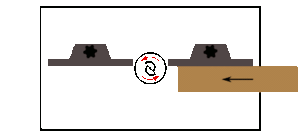

It is very important to realize that the exposed router bit is not only dangerous because of its sharp edges, but also because it can rip the workpiece out of your hand and let it fly across the workshop, or pull your hand into the danger zone. To make sure that you are in control and not the router, ONLY make push cuts, i.e. ONLY feed workpieces through from the right to the left side if you are working in front of the router bit and vice-versa! You should understand why this is important after getting the router introduction or reading articles about accidental climb cuts on the internet.
Please also see Project:Router Table in case you would like to join us in building your own.
(Emergency) Stop
To stop the router, you can slap the lid of the yellow switchbox or use the foot switch. When stopping inside a cut, the foot switch is highly recommended so you can keep your hands on the workpiece for full control!
In addition to unplugging the whole setup, please make a habit of "locking" the switchbox between uses (unlocked by pushing the red cover upwards) so we have maximum protection against accidental starts.
Setup
Dust Extraction
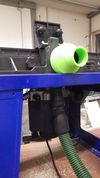
For edge work, you can use the top (green) dust port in the fence, but for grooves you should connect the shop vac to the bottom port in the rear cover of the table (Ferm router: black dust port on the machine itself). Keep in mind that the top port will only work if there is at least a small gap in the fence!
It will still be pretty messy work - a router generates lots of shavings - but should help reduce the amount of fine dust flying around.
Fence
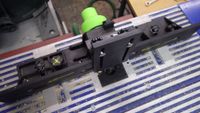
The fence consists of several parts which need to be aligned carefully if you want it to be accurate. In most cases (working with a parallel fence), you will not need the knob labeled "X", so please don't mess with it too much...the next user will thank you!
There is a scale on the table to set the fence's distance from the center of the router bit, but it is rather rough and doesn't allow accurate fine measurements. A height/depth gauge, easily made from a caliper and some scrap wood, would be a nice solution (similar to this Instructable, but there are better ones around for sure).
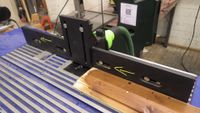
Once you have your bit inserted, the fence's two sliding front sections should be brought as close together as possible for maximum workpiece support and a focused airflow to the dust extraction port. The top guide should be brought down until it nearly touches your workpiece. The frontal guide works the same - we should make compatible featherboards that could actually press the workpiece to the table/fence for even more support.
Unfortunately, the current screw knobs have to be turned very tightly or vibrations will cause everything to shift over time - perhaps we can exchange these knobs with locking levers so that they can be adjusted without pliers.
Improvements/Upgrades
Any modifications to the table or router itself should be discussed with the owner (Martin) in advance and security-checked by a manager afterwards!
done:
- 3D printed shop vac adapter (needed some further adjustment with the table saw) - is the file available somewhere?
- cut two protruding corners from the front guide bracket so it stay mounted to the table all the time without getting in the way
- make push blocks
further ideas:
- make featherboards with slots that fit to the existing guide brackets
- replace (at least) the star knobs connecting the fence and the table with locking levers or knobs with hex nuts that can be gripped with wrenches (do those exist?)
- make (or buy) a height/depth gauge to set the fence distance or bit height
==> video showing these (and more) potential upgrades: Heiko Rech - Tipps zum Arbeiten mit dem Frästisch (DE)
Compatible Routers
These routers can be attached to the table.
- Makita 3612BR (default)
- do not remove without good reason!
- Ferm FBF-1050E (backup)
- caution: the mounting plate is off-center!
- bottom dust extraction requires the rear table cover to be removed
Inspiration
Here are some examples of projects you could use the router table for:
-
grooves like those needed for self-made drawers
-
cleaning up a partial-depth CNC cut with a flush trim bit (Project:TAC)
-
nice edges on small pieces
